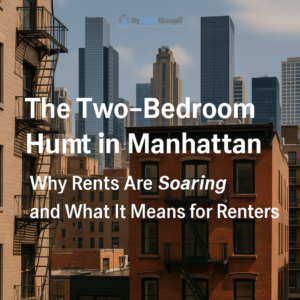If you’re looking for a two-bedroom apartment in Manhattan right now, brace yourself: competition is intense, inventory is shrinking, and prices are reaching record-breaking levels. This isn’t just a seasonal spike—it’s part of a growing trend that’s reshaping New York City’s rental landscape.
A Market on Fire: The Latest Rent Data
A recent Curbed article reveals that two-bedroom apartments are now the fastest-rising rent category in the NYC market. According to UrbanDigs, median rent for two-bedrooms in Manhattan rose 8.7% year-over-year, hitting a staggering $6,250 in May 2025. In Brooklyn, the rise wasn’t far behind, at 6.9%.
Other reports echo this alarming surge:
-
Douglas Elliman’s data from April recorded a median Manhattan two-bedroom rent of $5,735, a 10.4% increase compared to the same month in 2024.
-
The February 2025 median peaked at $5,995, marking the highest recorded level for two-bedroom units in the borough.
And this is all happening before the typical peak of the summer rental season—meaning prices could go even higher.
What’s Fueling the Price Hike?
Several factors are converging to push two-bedroom rents sky-high:
1. Inflation and Operating Costs
Landlords cite increased expenses related to building operations, maintenance, and materials. One building operator, Jamal Syed, explained how rising insurance costs and deferred pandemic-era repairs are forcing landlords to pass costs on to tenants. According to him, units that were around $4,700 in 2023 are now $5,400+ in 2025, and even those are flying off the market quickly.
2. Limited Supply, High Demand
There’s still a persistent inventory crunch in desirable neighborhoods. With fewer new developments and more families or remote workers looking for larger spaces, two-bedroom units are in especially short supply.
3. Roommate Economics
Two-bedroom units offer flexibility for roommates to split costs or for families needing dedicated space. However, this popular setup is now becoming less attainable, as prices increase faster than incomes.
4. High Mortgage Rates
Homebuyers are holding off due to interest rate uncertainty, which is keeping more people in the rental market—and pushing prices even higher.
Where the Pressure’s Strongest
Two-bedroom rents are spiking across Manhattan, but some neighborhoods are feeling the squeeze more than others:
-
Upper West Side: Popular for families, space is limited and rents are climbing fast.
-
Midtown and Downtown Manhattan: Corporate renters and relocating professionals are driving up demand.
-
Brooklyn Neighborhoods: Even boroughs once seen as affordable alternatives are catching up, with similar year-over-year hikes.
What Can Renters Do?
While the data is sobering, renters do still have options:
Act Fast
With limited inventory, desirable units don’t stay on the market for long. Being prepared with paperwork and a budget helps renters compete.
Consider Alternative Neighborhoods
Widen your search radius. Areas in upper Manhattan or outer boroughs may still offer some relative value.
Explore Rent-Stabilized Units
These units offer some predictability in a turbulent market. Use public tools to check if a unit is stabilized.
Negotiate or Look for Concessions
While rare during high-demand seasons, some landlords may still offer incentives like one month free rent or waived broker fees—especially if a unit has lingered.
Final Thoughts
This new normal isn’t just a bump in the road—it’s a structural shift. Manhattan’s two-bedroom market is more competitive than ever, pricing out even dual-income households and making it harder for families and roommates alike to secure suitable housing.
For many renters, navigating this market means being nimble, informed, and prepared for continued volatility. Understanding the “why” behind the rent hikes can help you plan your next move more strategically.
Source:
Curbed – The Two-Bedroom Hunt in New York Is Worse Than Ever: Read the full article here

